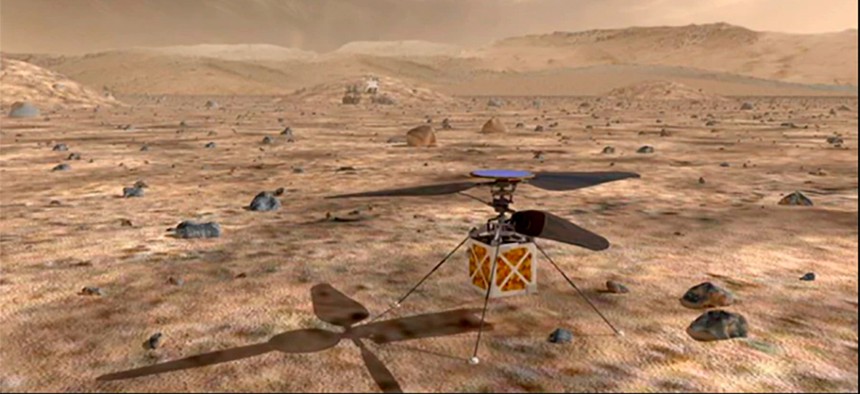NASA Soups Up Mars 2020 Robot with Hi-Def Ears and Its Own Drone

NASA JPL
The drone's helicopter rotors must spin 10 times faster than on Earth.
In a little over a Martian year (687 days), we will be sending robots back into space as part of NASA’s Mars 2020 Rover program, which is expected to launch in July or August of that (Earth) year. And this time, the pathfinding robot will be equipped with some of the latest technology, as well as years of added experience in the fields of artificial intelligence and autonomous drone research.
This new Rover will even come equipped with its own drone in the form of a helicopter that it will launch, a test to see if future robotic explorers could make use of a little flying backup.
When the original Mars Pathfinder launched in December 1996, it was a huge event, and even more so when it made landfall the following year on July 4, 1997. I was at a landing party that day and cheered with everyone else when the craft plodded down in its little bubble, bouncing across the surface of the red planet. We didn’t actually see anything, but still cheered when the news came in that Pathfinder had safely made landfall.
As impressive as Pathfinder was, it was more or less just a technology demonstration to see what worked, and what would need work, for the robots that followed. For example, we don’t bounce spacecraft down for a landing inside balloons anymore. This rover will be lowered to the planet on a giant sky crane.
To date, there have been four rovers from NASA that went to Mars, with Curiosity being the most recent, in 2012. Each robot pushed the boundaries and tested new designs, building on the ones that came before it.
The brains of the operation this time are based on the PowerPC 750 Architecture, a BAE RAD 750 processor operating at up to 200 megahertz. It also has two gigabytes of flash memory and 256 megabytes of dynamic RAM, plus 256 kilobytes of programmable read-only memory. Your smartphone is likely on par or even better, but for heavily ruggedized computers, that’s a powerhouse, and eight times as powerful as the Spirit or Opportunity rovers from 2004.
All that power will help the rover operate independently in the time between commands sent from Earth. With both Earth and Mars in motion, the distances between them change, so the delay for radio signals does as well, from four minutes on the low side to 24 when the two planets are farthest apart.
Besides powering this rover’s decision-making power so it won’t fall into a hole or run into something dangerous between commands, the extra power will enable the use of a new super-camera. That new device can analyze the chemical composition of rocks it encounters and scan for traces of water or even life, all from about 10 feet away from its target.
And this Mars rover is getting a whole new sense: hearing. Part of the camera now includes a microphone capable of high-definition audio recording. Those of us back on Earth will be able to hear what it’s like on another planet, recorded in three-minute bursts. It will probably just sound like an eerie wind, but I’m holding out hope for Calypso music.
And for the first time ever, this rover will have backup. NASA announced that an experimental helicopter would be deployed with the rover, making it the first heavier-than-air craft to take flight on another world—assuming it works. The Martian air is very thin, so the chopper’s blades need to spin ten times faster than it would on Earth to keep the four-pound unit aloft.
“The altitude record for a helicopter flying here on Earth is about 40,000 feet. The atmosphere of Mars is only one percent that of Earth, so when our helicopter is on the Martian surface, it’s already at the Earth equivalent of 100,000 feet up,” said Mimi Aung, Mars Helicopter Project manager at JPL. “To make it fly at that low atmospheric density, we had to scrutinize everything, make it as light as possible while being as strong and as powerful as it can possibly be.”
Helicopter flying technology demonstrations aside, the Mars 2020 mission is mostly all about science. The new rover will build on the others that came before it and try to answer some hard science questions once and for all. Specifically, it will try and discover if water ever existed on Mars, if there was or is any life there, and where and how humans might one day visit the planet.
It will also directly lay the groundwork for future missions. Part of its mission is to collect core samples of the soil there, seal them up in weather-proof containers, and store them in a depot at a spot still to be determined. The goal is to have a future mission go to Mars, collect those samples, and return to Earth. Whether that would need to be accomplished by humans, or if our increasingly intelligent robots could be tasked with the ultimate home delivery, remains to be seen.
John Breeden II is an award-winning journalist and reviewer with over 20 years of experience covering technology. He is the CEO of the Tech Writers Bureau, a group that creates technological thought leadership content for organizations of all sizes. Twitter: @LabGuys






